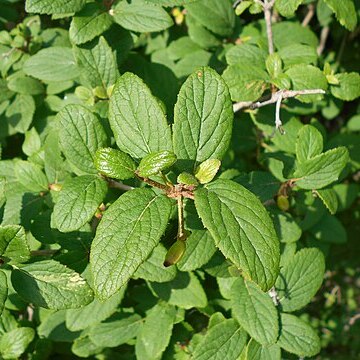Shrubs, deciduous, to 2 m tall. Bark gray-yellowish. Branchlets of current year yellow-whitish stellate-tomentose; branchlets of previous year yellow-whitish, very rounded, glabrous, with dispersed, small, rounded lenticels. Winter buds naked, yellow-whitish stellate-tomentose. Leaves always opposite, not clustered at apices of branchlets; stipules absent; petiole green, robust, 4-10 mm, yellow-whitish stellate-tomentose; leaf blade abaxially gray-greenish and adaxially yellowish green when young, broadly ovate to elliptic, rarely suborbicular, 2.5-5(-6) × 1.5-3 cm, papery, abaxially stellate-pubescent, adaxially stellate-pubescent or forked-hairy, midvein raised abaxially, lateral veins 4-or 5-jugate, pinnate, arched, branched, anastomosing near margin, raised abaxially, slightly impressed adaxially or inconspicuous, veinlets transverse, inconspicuous on both surfaces, not lobed, base rounded or cuneate-rounded, without glands, margin crenulate, with tips of teeth mucronate, apex acute or obtuse. Flowers appearing after leaves; inflorescence a compound umbel-like cyme, terminal, 1.5-3.5 cm in diam.; rays whorled; first node of inflorescence with 5 or fewer rays, few flowered, yellow-whitish stellate-tomentose, without large sterile radiant flowers; peduncle 5-10 mm; bracts caducous, leaflike, green, linear to linear-lanceolate, stellate-pubescent; bracteoles linear. Flowers mostly on rays of 1st order, not fragrant, sessile. Calyx greenish; tube oblong-tubular, 3-5 mm, glabrous; lobes repand, very small, 0.5-1 mm, glabrous, apex obtuse. Corolla yellowish whitish, tubular-campanulate, ca. 3 mm in diam., glabrous; tube 5-7 mm; lobes spreading, orbicular-ovate, ca. 1.5 mm, shorter than tube, apex rounded, margin entire. Stamens nearly as long as corolla, inserted near base of corolla tube; filaments ca. 6 mm; anthers yellow, oblong, ca. 2 mm. Styles taller than calyx lobes; stigmas capitate. Fruit initially turning red, maturing black, ellipsoid, ca. 1 cm, base rounded, apex rounded, glabrous; pyrenes compressed, oblong, ca. 8 × 5-6 mm, with 2 shallow dorsal grooves and 3 shallow ventral grooves, apex rounded. Fl. May-Jul, fr. Jul-Sep. 2n = 18(16).
More
A shrub. It grows 1.8-2.4 m high and spreads 1.2 m wide. It loses its leaves during the year. The leaves are 6 cm long and have teeth along the edge. The leaves are downy underneath. The flowers are white and in small flat open heads. The fruit are red berries. They are in clusters. They become black as they ripen.

